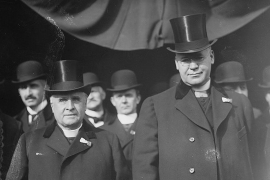The popularity of tweed is an old story – in 1826 a London merchant decides to buy some cloth from a weaver in Hawick, a town in the Scottish borders famous for its cloth production. Very happy with his order, he decides to get some more but – crucially – misreads the weaver’s dashed handwriting. Instead of ‘twill’ this Londoner reads ‘tweed’, and assumes this new cloth must take after the River Tweed which runs fast and clear through the textile areas of lower Scotland. ‘Tweed’ and not ’twill’ has been the term used ever since.
Today, tweed is an internationally recognised style of fabric synonymous with upper-class country clothing and outerwear, as well as with iconic Victorian gentlemen including Sir Arthur Conan Doyle’s Sherlock Holmes. Sidney Paget’s well-loved illustrations of the world’s most famous fictional detective (see above) have had a profound impact on the way we imagine him to look, and its telling that most caricatures of Holmes include a tweed deerstalker and cape.
With this in mind The Museum of London approached three historic companies to help them create a new tweed – a modern design taking inspiration from the classic Sherlock Holmes stories in collaboration with Christys’ Hats, Liberty London and Lovat Mill in Hawick, Scotland. Through an investigation into ‘Sherlock era’ (1881-1900) fashion collection at the Museum of London, they discovered that gold and blue were popular accent colours – incidentally amongst the most common colours mentioned in the stories – and, teaming this with a light grey to reflect the cityscape, the Museum of London ‘Sherlock Holmes’ tweed was born.









